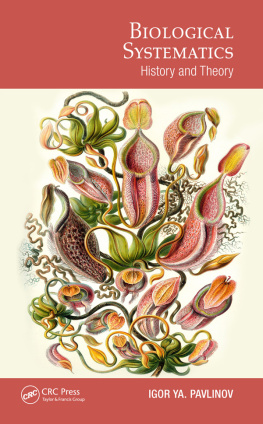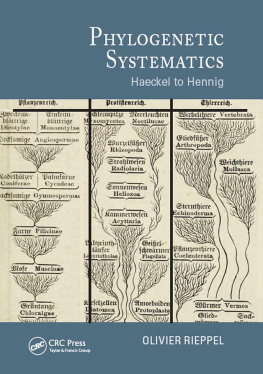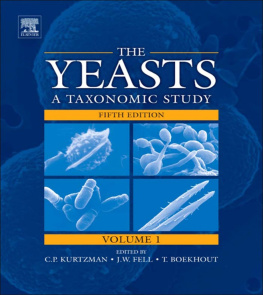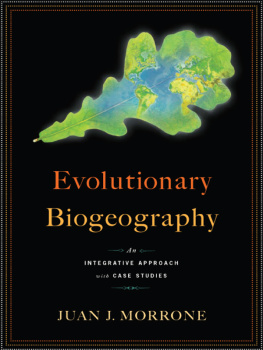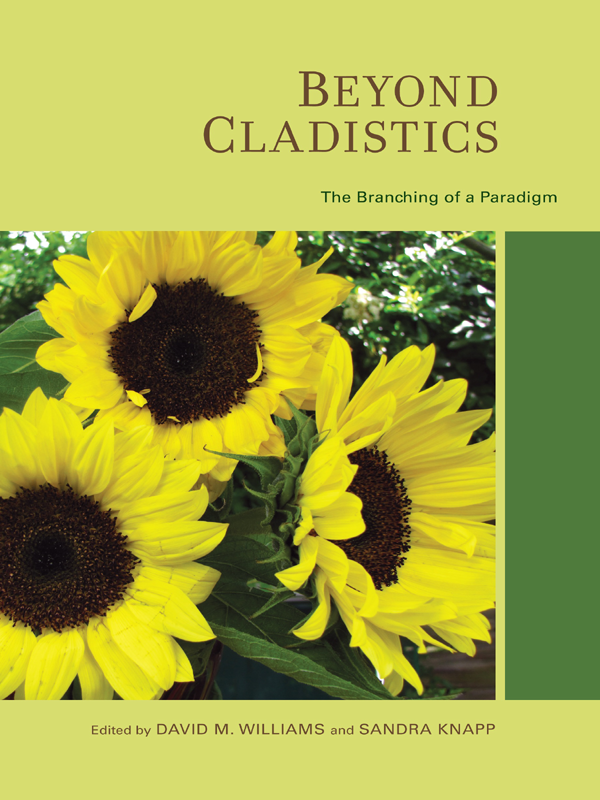EBSCOhost - printed on 12/9/2022 10:17 AM via . All use subject to https://www.ebsco.com/terms-of-use
The Species and Systematics series will investigate fundamental and practical aspects of systematics and taxonomy in a series of comprehensive volumes aimed at students and researchers in systematic biology and in the history and philosophy of biology. The book series will examine the role of descriptive taxonomy, its fusion with cyber-infrastructure, its future within biodiversity studies, and its importance as an empirical science. The philosophical consequences of classification, as well as its history, will be among the themes explored by this series, including systematic methods, empirical studies of taxonomic groups, the history of homology, and its significance in molecular systematics.
Editor in Chief: Malte C. Ebach (University of New South Wales, Australia)
Marcelo R. de Carvalho (Universidade de So Paulo, Brazil)
Anthony C. Gill (Arizona State University, USA)
Andrew L. Hamilton (Arizona State University, USA)
Brent D. Mishler (University of California, Berkeley, USA)
Juan J. Morrone (Universidad Nacional Autnoma de Mxico, Mexico)
Lynne R. Parenti (Smithsonian Institution, USA)
Quentin D. Wheeler (Arizona State University, USA)
John S. Wilkins (University of Sydney, Australia)
David M. Williams (Natural History Museum, London, UK)
University of California Press Editor: Charles R. Crumly
Copyright 2010. University of California Press. All rights reserved. May not be reproduced in any form without permission from the publisher, except fair uses permitted under U.S. or applicable copyright law.
EBSCO Publishing : eBook Collection (EBSCOhost) - printed on 12/9/2022 10:17 AM via
AN: 337607 ; David M. Williams, Sandra Knapp.; Beyond Cladistics : The Branching of a Paradigm
Account: ns075055
Contents
PART ONE
ON CHRIS
1. Chris Humphries, Cladistics, and Connections
David M. Williams, Kre Bremer, and Sandra Knapp
2. Ontogeny and Systematics Revisited: Developmental
Models and Model Organisms
Stephen Blackmore and Alexandra H. Wortley
3. Rooted in Cladistics: Chris Humphries, Conservationand Beyond?
Richard I. Vane-Wright
4. Do We Need to Describe, Name, and Classify All Species?
Quentin D. Wheeler
5. Floras to Phylogenies: Why Descriptive Taxonomy Matters
Sandra Knapp and J. Robert Press
PART TWO
BOTANY
6. Island Hot Spots: The Challenge of Climate Change
David Bramwell
7. Endemism and Evolution of the Macaronesian Flora
Mark A. Carine, Arnoldo Santos-Guerra, I. Rosana Guma, and J. Alfredo Reyes-Betancort
8. Early British Collectors and Observers of the Macaronesian Flora: From Sloane to Darwin
Javier Francisco-Ortega, Arnoldo Santos-Guerra, Charlie E. Jarvis, Mark A. Carine, Miguel Menezes de Sequeira, and Mike Maunder
PART THREE
CLADISTICS
9. Monophyly and the Two Hierarchies
Olivier Rieppel
10. Beyond Belief: The Steady Resurrection of Phenetics
David M. Williams, Malte C. Ebach, and Quentin D. Wheeler
11. Monographic Effects on the Stratigraphic Distribution of Brachiopods
Gordon B. Curry
12. The Eukaryote Tree of Life
Diana Lipscomb
PART FOUR
BIOGEOGRAPHY
13. Tethys and Teleosts
Peter L. Forey
14. East--West Continental Vicariance in Eucalyptus Subgenus Eucalyptus
Pauline Y. Ladiges, Michael J. Bayly, and Gareth J. Nelson
15. Wallacea Deconstructed
Lynne R. Parenti and Malte C. Ebach
EBSCOhost - printed on 12/9/2022 10:17 AM via . All use subject to https://www.ebsco.com/terms-of-use
Contributors
Michael J. Bayly
The University of Melbourne, Australia
Stephen Blackmore
Royal Botanic Garden Edinburgh, United Kingdom
David Bramwell
Jardn Botnico Viera y Clavijo, Spain
Kre Bremer
Stockholm University, Sweden
Mark A. Carine
The Natural History Museum, United Kingdom
Gordon B. Curry
University of Glasgow, United Kingdom
Malte C. Ebach
University of New South Wales, Australia
Javier Francisco-Ortega
Florida International University;
Fairchild Tropical Botanic Garden
Peter L. Forey
The Natural History Museum, United Kingdom
I. Rosana Guma
Unidad de Botnica Aplicada, Instituto Canario de Investigaciones
Agrarias, Jardn de Aclimatacin de La Orotava, Spain
Charlie E. Jarvis
The Natural History Museum, United Kingdom
Sandra Knapp
The Natural History Museum, United Kingdom
Pauline Y. Ladiges
The University of Melbourne, Australia
Diana Lipscomb
George Washington University
Mike Maunder
Al Ain Wildlife Park and Resort, Abu Dhabi;
Florida International University;
Fairchild Tropical Botanic Garden
Miguel Menezes de Sequeira
Universidade da Madeira Campus da Penteada, Portugal
Gareth J. Nelson
The University of Melbourne, Australia
Lynne R. Parenti
National Museum of Natural History, Smithsonian Institution
J. Robert Press
The Natural History Museum, United Kingdom
J. Alfredo Reyes-Betancort
Unidad de Botnica Aplicada, Instituto Canario de Investigaciones
Agrarias, Spain
Olivier Rieppel
The Field Museum
Arnoldo Santos-Guerra
Jardn de Aclimatacin de La Orotava, Spain
Richard I. Vane-Wright
National Endowment for Science, Technology and the Arts, United Kingdom;
Durrell Institute of Conservation and Ecology (DICE), University of Kent, Canterbury;
The Natural History Museum, United Kingdom
Quentin D. Wheeler
Arizona State University
David M. Williams
The Natural History Museum, United Kingdom
Alexandra H. Wortley
Royal Botanic Garden Edinburgh, United Kingdom
EBSCOhost - printed on 12/9/2022 10:17 AM via . All use subject to https://www.ebsco.com/terms-of-use
Preface
This book represents an attempt to document the nature and anticipate the future of cladistics. Inspired by the career and contributions of Chris Humphries, recently retired and now deceased botanist of the Natural History Museum (London), the breadth and depth of this one transformative career reflects decades of scientific advancement as well as the origination and wide acceptance of cladistics and its multifarious applications to botany, conservation, and biogeography.
Why Beyond Cladistics? The initial idea came from Gary Nelson (Patterson 1997; Nelson 2000) reporting a statement made by Colin Patterson: The cladistic revolution began in the late 1960s, accelerated in the 1970s, and was virtually complete by the eighties. The word




